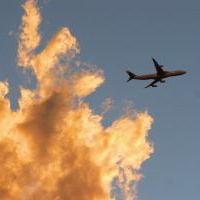 Reports have been floating around in the media for several weeks about how airlines are on the verge of making massive scheduling cutbacks this fall, which will supposedly decimate smaller airports and hike fares up to record levels.
Reports have been floating around in the media for several weeks about how airlines are on the verge of making massive scheduling cutbacks this fall, which will supposedly decimate smaller airports and hike fares up to record levels.
But that’s not entirely correct.
There will be some route cuts and fare hikes, but it’s not necessarily going to be a disaster situation.
So let’s separate fact from fiction with regard to who is cutting what and by how much, and what it all means for travelers as far as fare increases.
It’s a fact that airlines are cutting capacity by either 10 or 11 percent (depending on which source you use). Experts measure “capacity” in two different ways, and it’s an important distinction to make, for clarity’s sake: airlines can either reduce the number of flights scheduled to take off (departures); or cut the number of seats on a route by substituting smaller planes.
USA Today’s analysis of OAG data indicates that there will be a 10.4 percent reduction in domestic capacity this fall compared to last fall, which it defines in terms of total number of seats available. See that article here.
Aviation consultants The Boyd Group, whose analysis includes some international flights, predicts 9.3 percent fewer seats, and an 11 percent decrease in departures in November 2008 compared to November 2007.
Some airlines are making deeper cuts than others. Continental is parking 70 planes, and reducing 11 percent of its capacity overall; Frontier is cutting capacity by 17 percent; and United is dropping more than 100 planes. Southwest’s 5 percent reduction seems modest by comparison.
Though it’s true that some cities will be harder hit by the cutbacks, it is by no means limited to small rural airports, which have been the subject of much discussion in the press. Stewart International Airport (SWF) in New York State for example is apparently suffering so much from the 53 percent reduction in flights, that it’s currently seeking a buyer.
Check out our map of cities with big service cuts:
But The Boyd Group’s Mike Boyd warns not to over-emphasize the statistics that come out of small airports, because their small capacity skews the figures.
“Any airport with less than 150 monthly departures isn’t really a good example of anything,” he said. “A change in one flight a day will look really big. The percents imply disaster when there is none.”
Boyd noted that many of the big leisure destinations are losing capacity too. Honolulu has already lost 25 percent of flights compared to last year, due to the failure of two major airlines that served it. Las Vegas traffic is expected to be down by 16 percent, mainly because US Airways cut about half of its service to the city. And Orlando expects business to be down by 18 percent, primarily due to Delta cutting 45 percent of its flights there.
Boyd also stressed that the majority of the reductions are in the frequency and size of planes going to existing destinations. Many of the cuts affect mid-size cities, where service will be eliminated, or more likely reduced from prior levels.
“Most airlines are trimming the capacity tree, not clear-cutting entire major routes, unless you consider Erie-Atlanta a major opportunity for Southwest,” he said. “Carriers can’t toss as many flights around with oil at $100 a barrel.”
 For example, Frontier is cutting down on the number of flights between its Denver hub and 22 cities including Albuquerque, Hartford, Grand Junction, Rapid City and Spokane. JetBlue will still fly from Boston to Los Angeles, but no longer between Boston and San Jose, California. American Eagle is planning to fly eight fewer flights a day out of St. Louis, Missouri.
For example, Frontier is cutting down on the number of flights between its Denver hub and 22 cities including Albuquerque, Hartford, Grand Junction, Rapid City and Spokane. JetBlue will still fly from Boston to Los Angeles, but no longer between Boston and San Jose, California. American Eagle is planning to fly eight fewer flights a day out of St. Louis, Missouri.
So what does this mean for fares? They’re going up, but not doubling or tripling anytime soon. The airlines are trying to balance their need to shore up the bottom line with the desire to not scare away customers, so they’re raising the rent by about 15 percent overall, and 30 percent during Thanksgiving (compared to last year).
Again, some markets are seeing bigger increases than others. According to Farecast, getting from LaGuardia in New York to Chicago O’Hare will cost you 57 percent more this Thanksgiving than last, but flying from O’Hare to Miami is only 12 percent more. And the price of a ticket from Dallas to Atlanta is actually down $36, or 12 percent, from last year.
Year-over-year Thanksgiving airfare data for popular and major markets:
- Los Angeles – NY-JFK: Up $134 or 39%
- Dallas (DFW) – San Francisco: Up $42 or 13%
- Detroit – San Diego: Up $72 or 19%
- NY-LaGuardia – Chicago: Up $123 or 57%
- Newark – San Francisco: Up $113 or 32%
- Los Angeles – Seattle: Up $113 or 44%
- Pittsburgh – Orlando: Down $24 or -8%
- Dallas – Atlanta: Down $36 or -12%
- Denver – Los Angeles: Down $13 or -5%
Data courtesy of Farecast.com
The bright side is that many hotels are slashing their prices by up to 20 percent.
So it may end up costing you the same amount to travel and stay in another city because your increased airfare might just be canceled out by the discount on the hotel bill.
So much for “staycations.”
Related Links: USA Today, The Boyd Group’s Airport Data Miner USA, Farecast.com, CNN, Peter on the Today show, Previously on PeterGreenberg.com.
By Karen Elowitt for PeterGreenberg.com. Map by Corinne Crockett.
Read more of recent News Analysis of top stories.
Or learn more about flying in our Airlines & Airports section.












